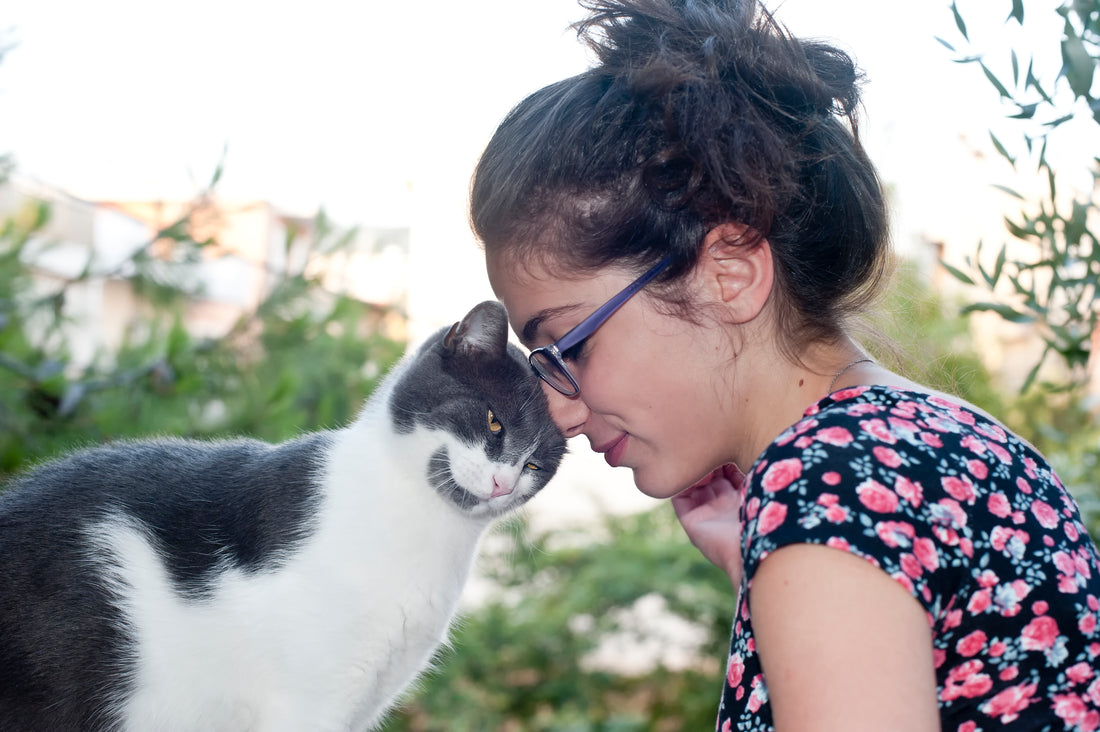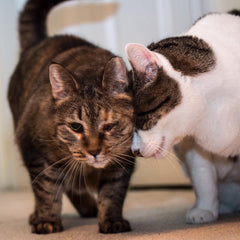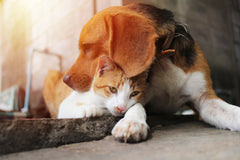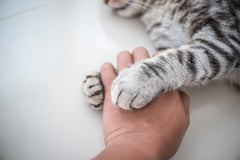
Cat Head Bunting: What It Means And How To Respond
Michelle at Vet Organics Tags: cat communication (8)cat health (56)
Cats are quirky, mysterious, and peculiar. They have many fun, and sometimes not-so-fun behaviors. They meow and purr, sleep on our faces, and become strangely entranced by dripping water. Many cat guardians ask about head bunting, and we agree, it’s a behavior worth learning more about.
What is cat head bunting?
 Some call it ‘head-butting.’ Others call it ‘head bumping.” Many kitty behavioral experts prefer ‘head bunting.” Whatever we call it, we can all agree, it’s a lovely sign of affection and trust. For many of us, our kitty will approach with a deep purr and press gently against our face and forehead. Sometimes they’ll even rub their face, from cheek to chin, along our face. For others, head bunting is more like a skull-to-skull headbutt. Either way, it’s a recognized gesture that shows we are an accepted member of the feline family.
Some call it ‘head-butting.’ Others call it ‘head bumping.” Many kitty behavioral experts prefer ‘head bunting.” Whatever we call it, we can all agree, it’s a lovely sign of affection and trust. For many of us, our kitty will approach with a deep purr and press gently against our face and forehead. Sometimes they’ll even rub their face, from cheek to chin, along our face. For others, head bunting is more like a skull-to-skull headbutt. Either way, it’s a recognized gesture that shows we are an accepted member of the feline family.
Scent Sharing
Just like many animals, cats have scent glands. Every animal has them in different places. Cats have scent glands all over their body, including their face. These glands excrete pheromones that have their scent. One of the reasons cats head bunt is to share their scent and mark you as one of their feline family. It’s less a dominance activity that marks territory and is more a sign of acceptance. Also called allorubbing, cats will head bunt other cats, dogs, people, and other companions.
Making a Request
 Cats only have so many ways to communicate with us. The meow is almost exclusively used to talk to humans, but it isn’t the only message system our cat-companions use. Among them is head bunting. It can often be used as an attention-getting behavior. Figuring out the actual message is up to the cat-guardian. Mr. Socks could be asking for scratches and a rub down. He could be asking for food or snacks. Or he might be asking for some playtime. If Ms. Kitty Fantastico head bunts and then flops over to expose her belly, she may be showing she’s relaxed and is showing us she trusts us, and the home we’ve provided.
Cats only have so many ways to communicate with us. The meow is almost exclusively used to talk to humans, but it isn’t the only message system our cat-companions use. Among them is head bunting. It can often be used as an attention-getting behavior. Figuring out the actual message is up to the cat-guardian. Mr. Socks could be asking for scratches and a rub down. He could be asking for food or snacks. Or he might be asking for some playtime. If Ms. Kitty Fantastico head bunts and then flops over to expose her belly, she may be showing she’s relaxed and is showing us she trusts us, and the home we’ve provided.
Social Rank and Bonding
Head bunting is a way cats mark their feline friends and family. It’s a stronger marker than leaving urine on objects to claim them, but instead of territory, they are claiming familial relationships. It turns out, there is a social system to head bunting, beyond simple signs of affection and acceptance. A more dominant cat with a higher social rank will be the one to initiate head bunting. It’s the job of the dominant, confident cat to spread the family scent and groom the other cats (and sometimes humans). This not only serves as a sign of trust and inclusion but is a bonding activity. This is true of feral cats and domesticated kitties.
How To Respond To A Head Bunt
Unless a dog has grown up around cats and had a good teacher, Fido may not know how to respond to head bunting. As pet parents, we now understand the many important functions of head bunting, and it’s our responsibility to react appropriately. Who would want to miss out on such an opportunity to bond and build a great relationship with our cat-companions?
 When our Frisky Whiskers head bunts us, the best action thing to do is try a few different responses and watch our kitties reaction. By being observant, we can better understand what our kitty is trying to tell us. Receiving is an important step in the bonding process, so simply receiving our kitty’s affection is the best place to begin. When we feel ready, we can try reciprocating in different ways. One of the first ways to respond can be with a bit of scratching. Try their forehead, cheek, chin, and any other favorite places. If they respond affectionately or enjoy it, this may be what they are looking for. If they leave or stop being affectionate, wait until they approach again later, and try a different response. Treats are a response worth trying, but we need to be careful we don’t train them to think head bunting will result in treats. We want to make sure we are learning what they want, not teaching them what we are willing to respond with.
When our Frisky Whiskers head bunts us, the best action thing to do is try a few different responses and watch our kitties reaction. By being observant, we can better understand what our kitty is trying to tell us. Receiving is an important step in the bonding process, so simply receiving our kitty’s affection is the best place to begin. When we feel ready, we can try reciprocating in different ways. One of the first ways to respond can be with a bit of scratching. Try their forehead, cheek, chin, and any other favorite places. If they respond affectionately or enjoy it, this may be what they are looking for. If they leave or stop being affectionate, wait until they approach again later, and try a different response. Treats are a response worth trying, but we need to be careful we don’t train them to think head bunting will result in treats. We want to make sure we are learning what they want, not teaching them what we are willing to respond with.
Head Bunting versus Head Pressing
Almost the opposite of head bunting is head pressing. When a cat presses their head against us, a wall, or other surfaces, it’s a sign of severe discomfort. It could be the result of hypertension, head injury, a tumor, or a developing neurological problem. Watch for wincing, vocalizing, irritability, and disorientation. Any and all of these behaviors mean there is a medical emergency and a vet visit should happen immediately.
What If A Cat Doesn’t Head Bunt?
 All this talk about cats and head bunting behavior can make it seem like those who don’t head bunt are unusual. But we have nothing to worry about. Kitties are different everywhere, and there are a wide range of communication methods a cat may prefer. While head bunting is a way many cats express trust and friendship, a cat that doesn’t use this method is not a problem. It just means they show their affection in other ways. Watch for slow blinks, grooming or licking us, and cats who bring us gifts, such as rodents, toys, and insects. Many cat guardians miss it, but when cats show excitement at our return home by greeting us at the door, they are showing affection and trust. An upright tail, kneading, and even the simple act of being near us and sharing space are bonding activities. Cat love is often subtle, so the key is to observe and learn what our cats are really telling us.
All this talk about cats and head bunting behavior can make it seem like those who don’t head bunt are unusual. But we have nothing to worry about. Kitties are different everywhere, and there are a wide range of communication methods a cat may prefer. While head bunting is a way many cats express trust and friendship, a cat that doesn’t use this method is not a problem. It just means they show their affection in other ways. Watch for slow blinks, grooming or licking us, and cats who bring us gifts, such as rodents, toys, and insects. Many cat guardians miss it, but when cats show excitement at our return home by greeting us at the door, they are showing affection and trust. An upright tail, kneading, and even the simple act of being near us and sharing space are bonding activities. Cat love is often subtle, so the key is to observe and learn what our cats are really telling us.
For more about cat behaviors and how to learn about what they are telling us, check out this article about cat kneading, “Why Do Cats Knead?” or check out this piece, “Cat Communication: Are You Listening?”
Further Reading:
- "Bunting Behavior," Cat Behavior Expert, Pam Johnson-Bennett
- "Why Do Cats and Dogs Love a Good Head Scratch?" Live Science
- "The Art of Bunting," Catnip, Cummings School of Veterinary Medicine at Tufts University
